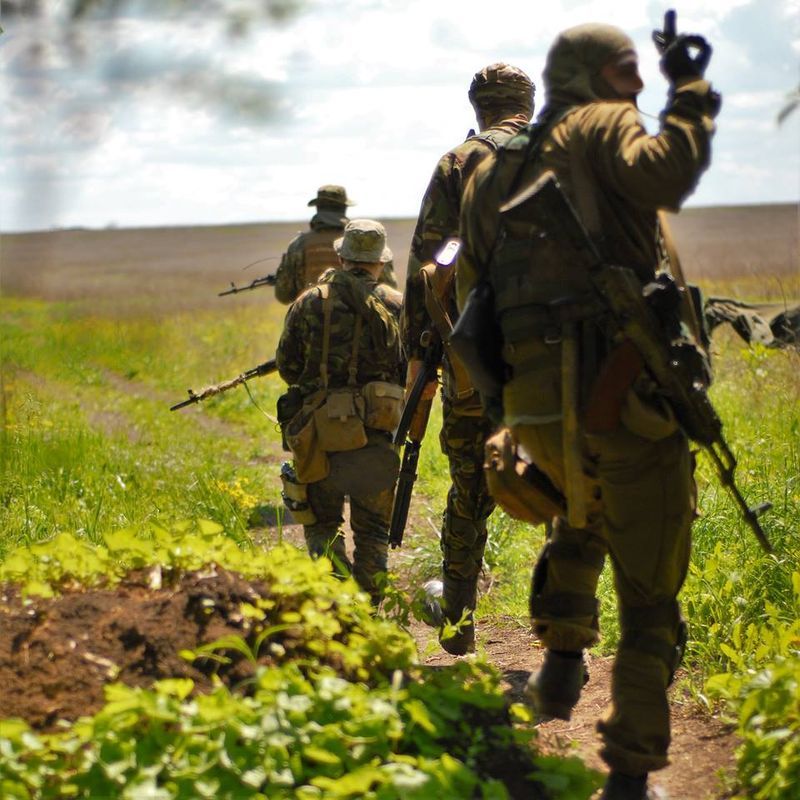
Battlefield reconnaissance. They work invisibly, anonymously, relying only on their own strengths. However, without this type work Victory is impossible.
“Pol” and “Yarik” are the cover names of two reconnaissance men from the 20th separate motorized infantry battalion of the 93rd SepMBde. Sturdy men, who resemble medieval Vikings. Calm and well-balanced. One sees confidence and intelligence in their eyes.
“I had no prior experience of military service, nor did I participate in hostilities, - “Pol” tells us - In 2016 I signed a contract and I was sent to the 93rd brigade. After a talk with the Chief of Staff of the 20th Battalion I became a reconnaissance man”.
“Yarik” has a slightly different story.
“After my mobilization I was commissioned to an anti-aircraft missile regiment, - says the reconnaissance man. – That was back in 2015. I was in the 2nd line of defence, not further. I felt that I did not deserve the status “Participant of combat operations” that had been granted to me. My father, an experienced volunteer, suggested that I join the 20th Battalion. That is what I did, to prove to everyone and to myself that I was worthy of the status “Participant of combat operations”, and that I contributed to our Victory”.
Both guys say that the specifics of the work battlefield reconnaissance men have to do is very different from the stereotypes created by cinematographers. Practically half their time is spent on territory which is controlled by the adversary. The front edge of enemy formations is constantly reconnoitered into the depths of up to 5 kilometers, because the situation there can change in the time span of a single day.
Data collected during surveillance is transferred to headquarters, after that decisions are made. Sometimes there are specific combat tasks, which only reconnaissance can handle - organize an ambush, destroy adversary reinforcements, capture prisoners, and so on.
When you go to the “other side”, the scouts say, you never know whether you will return. What awaits there? Where and what types of mines have been installed in the last 24 hours, which forces were pulled up by the enemy, what kind of traps have been set ...?
Under Slovianoserbsk the group of battlefield scouts was surrounded by seven dogs - trained huskies, natural hunters. A GPS-navigator was attached to the collar of each one. In other words, the canine handlers of the terrorists knew where their dogs were from afar. The fighters had to use weapons for self-defense and, to deceive the enemy, one of the huskies was dropped off as far as 2 kilometers away from the place of the attack.
To succeed in this kind of work one needs the highest moral qualities and to understand what all of this is for.
“My motivation is the following, - says “Yarik”. - The end of the war is nowhere in sight. Therefore, I want to influence the process, to prevent the spread of the terror of Putin forces to other regions. Only Victory will satisfy us”.
Physical training and especially endurance are important for a battlefield reconnaissance man. After all, their work mainly deals with surveillance. Remain undetected, approach covertly, gather information and return. When it comes to shooting, the use of weapons means one thing - exposure and failure of the operation.
As to the characteristics of the enemy, which the fighters of the 20th Battalion and the 93rd Brigade have had to deal with - they are rather diverse.
“For the most part, they are local laborers,” says “Pol”. - They act without any ideology or fanaticism”.
For example, in the Red Liman settlement an elderly man was working in his field. Then he went home, took a sub-machine gun and went to work at a checkpoint.
There are also many Russian Cossacks-terrorists in “kubankas” (Ed. flat round fur hats). They rob abandoned houses and engage in looting without giving it a second thought.
“I would say that, for the most part, our adversary is a gathering of prowlers, - says “Pol”. - They join for the money or the prospect of plunder. There is no mutual supportiveness between units. Their weapons are similar to ours. Although, in terms of equipment, their situation is slightly better. I’m speaking about tactical equipment, unloading systems”.
However, the efforts of reconnaissance men of the 20th battalion have been mainly focused on a reconnaissance troop of the 4th motorized rifle brigade of the so-called 2nd army corps. As a result of numerous combat clashes up to 80% of the personnel of the reconnaissance troop has been wiped out. None of the officers or the instructors remain. A group of Russian officers even arrived to the area to investigate the reason for such significant losses.
“A special shock for the fighters was the elimination of the “Aleks” group at the end of June, - “Pol” recalls. – He was an instructor, a Russian officer of Shcherba from Kirov. When he encountered us his actions were daring. He instantly retrieved a sniper rifle from behind his back and opened fire from the thigh. We failed to capture him alive. However, two of the six terrorist reconnaissance men were killed, four of them, including the notorious Russian commander Agieiev, were detained. The death of the instructor who had been teaching the militants how to run sabotage and reconnaissance operations led to the complete loss of morale among the enemy. It came to the point when they went to the toilet only in pairs. Gossip started spreading about a secret Ukrainian special forces unit which was working against them...”
Battlefield reconnaissance does not come down to monitoring the front line of the enemy. Thanks to their excellent combat training and high moral-and-psychological qualities, reconnaissance men are viewed by the Command as versatile fighters who are entrusted with fighting enemy saboteurs, escorting important persons, operational response to crisis situations at the front, etc. After all, who can we rely on if not battlefield reconnaissance...